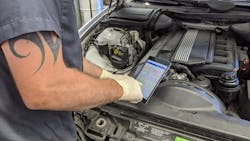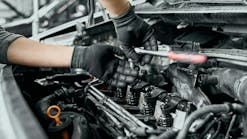How to safely perform digital inspections for hybrid and electric vehicles
As the automotive industry shifts toward electrification, repair shops must evolve to meet the unique challenges of hybrid and electric vehicle (HEV and EV) inspections. Traditional inspection methods are no longer sufficient to address the complexities of these advanced vehicles. Digital Vehicle Inspections (DVIs) offer a modern solution that enhances safety, efficiency, and accuracy. However, performing these inspections requires a thorough understanding of EV systems and specialized tools.
In this blog, we will provide a step-by-step guide to conducting safe and effective digital inspections for hybrid and electric vehicles, focusing on essential tools, best practices, and safety precautions.
Step 1: Understand the differences between HEVs/EVs and ICE vehicles
Before diving into the inspection process, it’s crucial to understand how hybrid and EV systems differ from traditional internal combustion engine (ICE) vehicles:
- High-voltage systems: EVs operate on high-voltage electricity, which requires specialized safety procedures to avoid injury.
- Battery-centric design: The battery is the most critical and expensive component in an EV, requiring detailed health assessments.
- Regenerative braking: Unlike ICE vehicles, EVs recover energy through regenerative braking, impacting wear and tear on the braking system.
- Fewer moving parts: EVs have fewer mechanical components, shifting the focus to software and electrical diagnostics.
Step 2: Equip yourself with the right tools
To perform accurate digital inspections, you need specialized tools and software:
- DVI software: Choose a platform that allows you to create detailed inspection reports with photos, videos, and customer-friendly explanations.
- Battery analyzers: Evaluate battery capacity, state of charge, and state of health.
- High-voltage testers: Use insulation resistance testers to check the integrity of high-voltage cables and components.
- Thermal imaging cameras: Detect overheating in the battery and high-voltage systems.
- OBD-II scan tools with EV capabilities: Access and interpret EV-specific diagnostic codes.
Step 3: Follow safety protocols
Working with high-voltage systems can be dangerous if proper precautions aren’t taken. Here’s how to stay safe:
- De-energize the system: Before inspecting any high-voltage components, ensure the system is de-energized following the manufacturer’s guidelines.
- Wear personal protective equipment (PPE): Use insulated gloves, safety glasses, and high-voltage protective clothing.
- Follow manufacturer guidelines: Always consult the vehicle’s service manual for specific safety procedures.
Step 4: Conduct a comprehensive inspection
Here’s a checklist of key areas to inspect:
1. Battery health
- Test the State of Health (SOH) and State of Charge (SOC).
- Check for signs of thermal issues or cell imbalances.
2. High-voltage system integrity
- Inspect cables, connectors, and insulation for wear or damage.
- Perform resistance and continuity tests.
3. Regenerative braking system
- Evaluate the transition between regenerative and friction braking.
- Check for abnormal noises or performance issues.
4. Thermal management
- Inspect the cooling system, including hoses, pumps, and coolant levels.
- Use thermal imaging to identify hotspots.
5. Charging systems
- Test the onboard charger and charging port for functionality.
- Verify compatibility with different charging stations.
Step 5: Communicate findings to customers
One of the greatest advantages of DVIs is their ability to enhance customer communication. Use the digital report to:
- Provide visual proof: Include photos and videos of any issues found.
- Explain the impact: Help customers understand how the identified problems affect their vehicle’s performance and safety.
- Recommend solutions: Offer clear, actionable recommendations for repairs or maintenance.
Conclusion
Performing safe and effective digital inspections for hybrid and electric vehicles is essential for staying competitive in today’s automotive industry. By investing in the right tools, following safety protocols, and focusing on critical EV components, your shop can deliver superior service while building customer trust. Embrace the future of vehicle inspections with DVI and position your shop as a leader in the electrification era.
"Future-Proof Your Diagnostic Skills” March 5, 2025 1-2 p.m. EST
High-voltage systems, regenerative braking, advanced batteries—EVs demand a new approach to inspections. In this free webinar, discover the tools and software that simplify Digital Vehicle Inspections for HEVs and EVs.
- DVI Basics
- Hybrid & EV Focus Areas
Industry Best Practices Don’t miss this opportunity to stay ahead of the curve. Register at https://attendee.gotowebinar.com/register/2236846900856571734?source=Blog.



